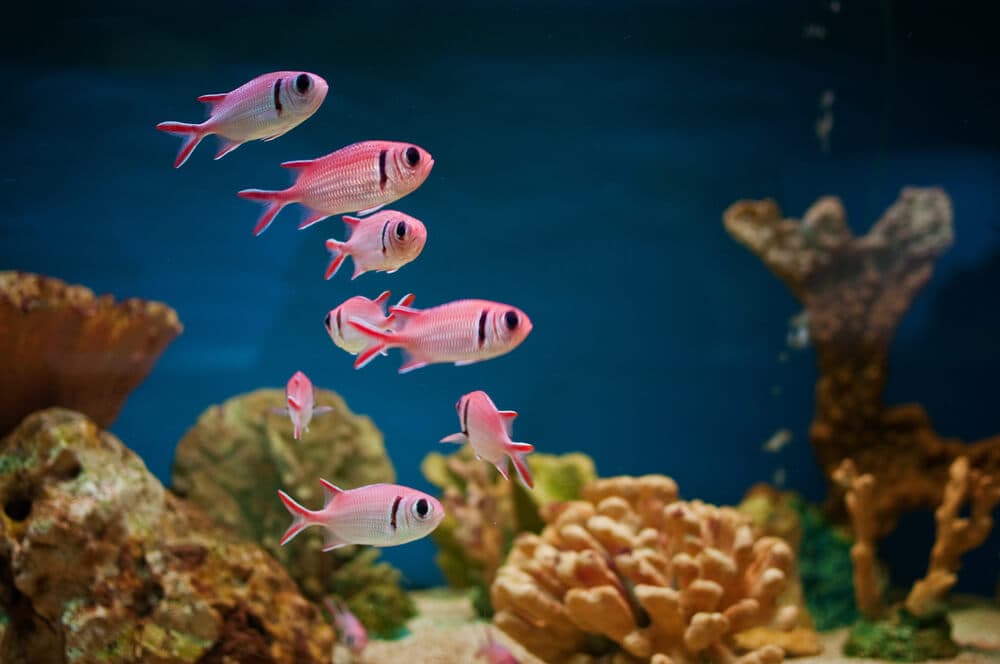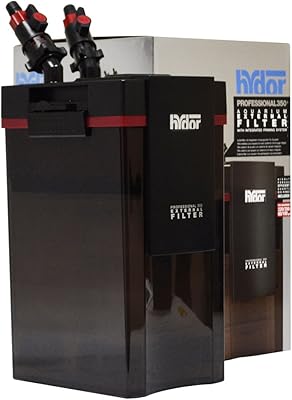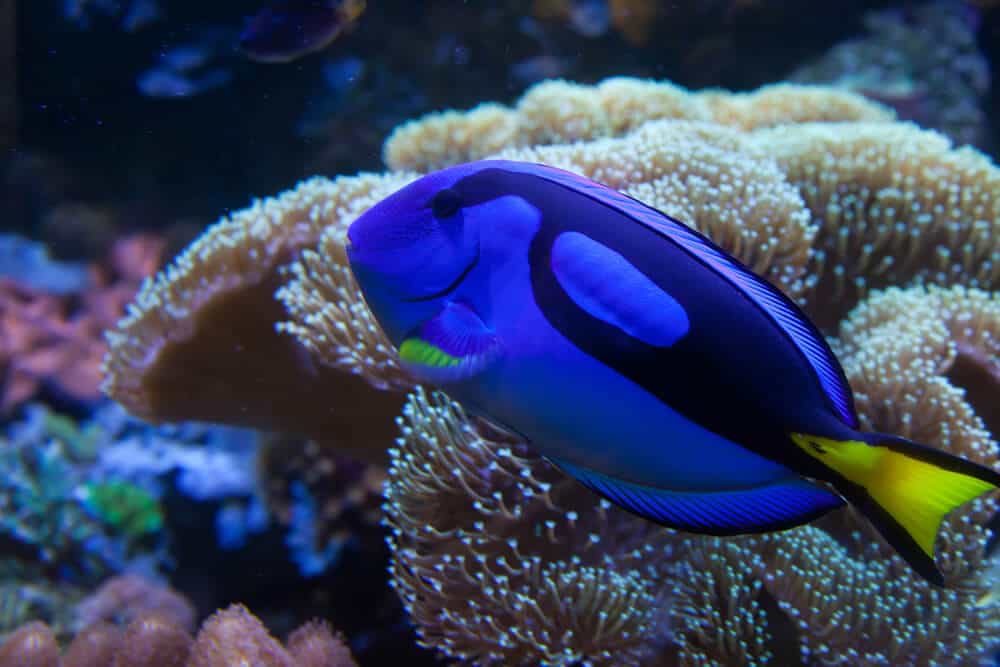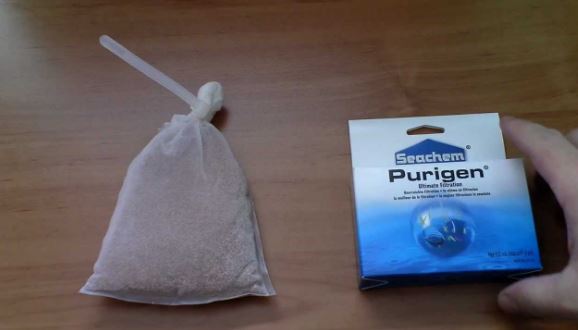
Everyone knows great filtration is a must for healthy fish and beautiful tanks. Anyone who has looked into the aquarium filter market also knows how many choices, options, and possibilities are available.
We’re here to help reinforce your choice of a canister filter for your tank. We’ll also show you the best aquarium canister filters available today.
See also:
9 Aquarium Filter Types – Don’t Choose the Wrong One!
Let’s get started by looking at the main considerations for shoppers.
Contents
- A/ Things to Consider When Choosing a Canister Filter
- B/ The Seven Best Canister Filters for Your Freshwater&Saltwater Aquarium
- Penn Plax Cascade Filter
- Fluval External Filter
- EHEIM Classic Filter
- Aquatop Canister Filter
- Marineland Canister Filter
- Hydor Canister Filter
- Polar Aurora Filter
- #1 – Penn-Plax Aquarium Cascade
- #2 – Fluval External Filter
- #3 – EHEIM Classic External Canister Filter
- #4 – Aquatop CF Series Canister Filter
- #5 – Marineland Magniflow Canister Filter
- #6 – Hydor Professional External Canister Filter
- #7 – Polar Aurora External Aquarium Filter
- C/ Our Choice
A/ Things to Consider When Choosing a Canister Filter
All canister filters have two main functions:
- Move the correct amount of water through the filter.
- Clean the water thoroughly using mechanical, biological, and chemical methods.
These are the main ideas to keep in mind when you are searching for the best filter.
- Considering your tank setup, you should choose a filter that moves enough water.
- Then you should consider the quality of filtration being provided within the canister filter.
To help you, we’re going to explore these two features in depth. Then we’ll show you a quick comparison table. Afterwards, you’ll have everything you need to know in order to make a brilliant choice for your next filter.
#1 – Tank Capacity and Filter Flow Rate
The first, and most important, thing to consider when choosing any filter for any tank is the filtration flow rate requirement.
You should already know your tank’s size in gallons (or liters). Every filter comes with a manufacturer’s specifications. The spec will tell you how many gallons of water the filter will pump per hour. Seems simple, right?
The Research
Yes and no. To be clear, there is no direct evidence requiring a certain amount of filtration. You can see this article from the International Journal of Recirculating Aquaculture for a lot more detail. Their conclusion is a water exchange once per hour is probably enough for fish health.
On the other hand, hobby fish tanks are different systems than large fish farm systems. A beginner’s guide recommends 3-5 water exchanges per hour. This means your filter should pump at least three times the amount of water in your tank every hour.
Thus, if you have a 25-gallon tank, then your filter should move at least 75 gallons per hour. It would be better to move 125 gallons per hour.
The Goal
You should aim for a sweet spot between too much water movement and too little filtration. Here’s why:
- If your filter is moving too much water, then you can harm your fish, shrimp, and plants. The increased flow rate may require fish to swim actively too often. Increased exercise may stress the fish and lead to health problems. Plants may have tissue damage from being moved in the current too forcibly. This is especially true of stem plants with large leaves.
- If your filter is not moving enough water, then you can have different problems. Your tank is – probably – rectangular. If your filter isn’t moving enough water, then the corners of your tank can become breeding grounds for ammonia-producing bacteria. A low flow rate may also be ineffective at sweeping organic matter into the filter where you can remove it.
If you can hit this sweet spot, then your fish and plants will thank you.
#2 – Filtration System
Every filter is designed with a filtration pathway for your water. The water enters the filter through the hose and passes through several sets of filter media. These can include sponges, filter floss, activated charcoal, UV sterilizers, and water polishing pads.
Choose a filter that can be set up to match your needs. All our filter choices can be customized to some extent. Here are a couple of examples of choices you can make:
- Extra dirty fish, such as a goldfish or predatory fish, will produce more solid waste. A filter with extra space for mechanical media (sponges and floss) will help keep this tank clean.
- A tank without plants may produce more algae because of lower competition for nutrients. A UV sterilizer can help to combat sudden algae blooms.
Plan your filter setup to maximize the filter’s efficiency for your tank. You will be rewarded with clear water and happy fish.
#3 – Other Helpful Features
The features we’ve just mentioned are standard for all canister filters. Clever engineering and planning have created few extra features. These are found on some models and not others.
Let’s take a look and see which one you like best.
Self-Priming Function
Canister filters do not sit inside the tank. This means they are not installed with water inside the filter. The pump must be primed with water to begin operation, so it does not run dry and burn itself up.
Some canister filters offer a self-priming or an easy-priming function. A button or small slide accomplishes this task. We recommend you choose a filter with this self-priming function to make setup and maintenance much easier.
Adjustable Flow Rate
Adjusting the flow rate of your filter is useful for at least two different reasons:
- Reducing the flow during feeding times may help food remain on the surface or in the correct place in the water column. It may also help your fish catch their food if they are slow, such as ornamental goldfish.
- Your filter may move too much water. Turning down the flow rate can help you customize your filter to your tank.
UV Light
A UV light works by sterilizing the water as it passes in front of the UV bulb. This should kill bacteria and other micro-organisms.
Some canister filters have UV sterilizers built into them. The UV sterilizers are placed in the filtration process after the water has circulated past the other filters.
While this may seem an optional extra to some people, it will result in a cleaner tank and may help combat algae blooms or bacteria spikes.
Spray Bars
The water being returned to your tank will be moving at a high velocity. Spray bars, or spreader bars, split this water into multiple smaller streams. This reduces the force of water movement in your tank.
Depending on your fish and plants, the return from your filter may be too strong. If this is true, then you will need a spray bar.
If your chosen filter doesn’t come with its own bar, then plan to buy one before you install the filter.
#4 – Additional Considerations
All the above features make canister filters a great choice for larger tanks. We should point out a few more things to help you make a wise choice.
Customer Reviews
In the world of eBay, Amazon, and Shopify, customer reviews are taking on more and more significance. As you do your research, you can look for common issues mentioned in reviews.
Some filters may not be a good match for every tank setup, though. You should read reviews but not necessarily heed everything someone else has said on the internet.
Warranty
Everyone hates returning stuff. What everyone hates more is when something breaks just after the warranty has expired.
Help your future self by looking for products with a long warranty period. This usually means the manufacturer stands behind their product’s build quality.
Price
The only way to compare prices is to look at the main feature of filters. There is a large price difference between the less expensive models and the most expensive models.
Some brands can sell for two or three times the price of others. With identical features and functions, you must make your own value choice.
B/ The Seven Best Canister Filters for Your Freshwater&Saltwater Aquarium
Now we’re going to show you our choices for the seven best canister filters on the market today. We’ll begin with a handy comparison table.
Penn Plax Cascade Filter
- Easy Push Button Primer
- UV Light
- Flow Rate Control
- Spray Bar
- 3-year warranty
Fluval External Filter
- Easy Push Button Primer
- UV Light
- Flow Rate Control
- Spray Bar
- 3-year warranty
EHEIM Classic Filter
- Easy Push Button Primer
- UV Light
- Flow Rate Control
- Spray Bar
- 6-month warranty
Aquatop Canister Filter
- Easy Push Button Primer
- UV Light
- Flow Rate Control
- Spray Bar
- 6-month warranty
Marineland Canister Filter
- Easy Push Button Primer
- UV Light
- Flow Rate Control
- Spray Bar
- 3-year warranty
Hydor Canister Filter
- Easy Push Button Primer
- UV Light
- Flow Rate Control
- Spray Bar
- 2-year warranty
Polar Aurora Filter
- Easy Push Button Primer
- UV Light
- Flow Rate Control
- Spray Bar
- 1-year warranty
After that, we’ll break down the pros and cons of each unit. Once we’re done, we’ll tell you which we think is best.
#1 – Penn-Plax Aquarium Cascade
Penn-Plax has been producing pet supplies for more than 60 years. What began as a pet shop in Brooklyn has become a global supplier of equipment for all kinds of pets. The Penn-Plax aquarium range has some very good filters, decorations, and equipment you should consider.
Specifically, the Penn-Plax Cascade 1000 is a great value filter for aquariums up to 100 gallons. This compact unit moves up to 265 gallons of water per hour through its three media baskets. It will pump 100 gallons of water in about 23 minutes. Your water should be sparkling clean and fresh.
The valves on the Cascade are a real advantage. Each one rotates through 360°. You should be able to set this filter up in even the tightest aquarium cabinets because the tubes can be turned in any direction to suit the space. In addition to their rotation, the valves are also engineered with shut-off controls which also serve as flow adjusters.
The media baskets are large enough to accommodate any type of filter media. Customizing your filtration to meet your tank’s needs is easy to accomplish. Filter media is shipped with the filter but may need to be replaced with something suitable for your tank.
All these advantages come at a very low price. Four other filters cost more than this sleek beauty.
There are some disadvantages you can think through. The media baskets are not always the easiest to install. The filter media included with the filter is also a bit limited. You may want to add better media to the filter yourself. Also, there is a 3-year warranty available. However, customer service in countries other than America can be limited to dealing with the retailer.
Pros:
- Great price
- Easy setup and maintenance
- Useful, high-quality valves
- Priming button works well
Cons:
- Limited customer service outside the USA
- Filter media is limited
Let’s watch the video below to know how to install this canister filter.
#2 – Fluval External Filter
Fluval is another top brand in the hobby aquarium market. Their filters and accessories are sold all over the world and trusted by hundreds of thousands of happy customers. Fluval’s products are renowned for their reliability and high build quality.
Fluval’s series of canister filters ranges from the 106 to the 406. The 106 pumps 145 gallons per hour while the 406 moves 383 gallons per hour.
For a 100-gallon tank, the 406 would be ideal. It can pump 100 gallons of water in only 15 minutes. This high level of filtration is essential for clear, fresh water and will lead to healthier fish.
Inside the filter, Fluval has engineered its new series to use better motors and impellers. They estimate their motor’s performance has increased its flow rate and head pressure. The impeller is also between 8-16% quieter than previous generations. They have re-engineered the impeller cover to increase its durability.
Maintaining the filter is easier than ever due to several new advances.
- First, the patented Aqua-Stop valves make disconnecting the hoses less troublesome and leaks less likely.
- Second, the lift-lock clamps operate with a single motion to make access easier as well as a more secure seal. Hose lock nuts increase the security and sealing even more.
The filtration pathway has been designed to keep the water inside the filter for as long as possible. Water moves through several filter media baskets before being pushed back into the tank. Many users describe their Fluval filters in glowing terms and report brilliant water quality after using them.
The big downside to the Fluval filter is its price. It is tied for the most expensive filter on our list. The price does come with a 3-year warranty, though.
Pros:
- Very high filtration rate
- Superb build quality
- Excellent design of water path through filter
- Good clamping system
Cons:
- High price
Below is the overview and setup video of the Fluval 06 series canister filter.
#3 – EHEIM Classic External Canister Filter
German machining is praised around the world for its accuracy and quality. This filter from EHEIM is no exception to this rule. The build quality is very good, and the design is intelligent and thoughtful.
The filter we suggest, for this review, is the EHEIM Classic 350. The 350 is designed for tanks up to 100 gallons. Smaller versions are available for smaller tanks.
EHEIM’s units come a striking green color. Filtration is achieved in a single canister of filter media rather than in separate trays. However, there is plenty of space for different kinds of filter media.
EHEIM sends its units out with all the necessary filter media. There is an activated carbon pad, as well as a coarse and fine filter sponge pad.
The motor and impeller are the latest in a long line of great products from EHEIM. The design tolerances are very good, and users report quiet running for months.
However, there are some things you might want to consider. First, and most importantly, the flow rate is much lower than competitors. The advertised flow rate is only 136 gallons per hour. This is less than half the specified rate of the Fluval canister filter. Second, the price is high for such a small flow rate.
Pros:
- Lots of filter media included
- Good color of unit
- Great build quality
- Very quiet operation
Cons:
- No self-priming function
- Very short warranty
Below is how to setup and install Eheim Classic Canister Filter video.
#4 – Aquatop CF Series Canister Filter
Aquatop’s CF Series is the first filter in our list with a big change in capability. This little beauty comes equipped with a UV Filter for extra cleaning power.
UV sterilizers work for your aquarium by sterilizing the water after it has passed through the other filter stages. The light wavelengths emitted by UV lights kill microorganisms such as bacteria and algae. Given enough time, they will even kill larger little beasties such as protozoa.
Apart from the UV sterilizer, this canister filter is built well. The pump has a self-priming feature. This means you don’t need to siphon water down to the filter before using it.
There are three stages of filtration prior to the UV sterilizer. These are coarse and fine sponges, and then a space for biological filtration of your choice.
The CF series of filters allows for different tank sizes. The smallest filter moves 264 gallons per hour while the largest, the CF500, moves up to 525 gallons per hour. In the middle is the CF400, which moves 370 gallons per hour. For a 100-gallon tank, the CF400 is the best choice.
Knowing the correct size reveals one of the disadvantages of this filter – its price. It’s 50% more expensive than other filters such as the Penn-Plax Cascade. The Aquatop also has the lowest customer review score on Amazon at the present time. While every filter doesn’t work for every person or tank, the high number of low reviews might be enough to make you look elsewhere.
Pros:
- UV sterilizer included
- Self-priming pump
- Good filtration design
Cons:
- Poor customer reviews
- Pricier than other, similar filters
How to set up Aquatop canister filter video.
#5 – Marineland Magniflow Canister Filter
The fifth canister filter on our list comes from MarineLand. The Magniflow canister is a great entry in the budget category. It has some simple features that should make maintenance easy.
To begin with, the valves come with a very simple valve stop system. An easy lift of the red lever disconnects the valves. Water stops flowing and this helps prevent leaks from ruining your maintenance routine.
In addition to this, the whole unit seals with a simple push motion. This isn’t as complicated as the locks and levers on other units. Fewer moving parts means less opportunity for breakdowns.
A quick prime button finishes the maintenance features with an easy way to restart the filter after it has been cleaned and serviced.
Water passes through four filtration stages. First is a simple mechanical stage consisting of sponges and pads. The second and third stages are chemical and biological filtration with activated carbon and bio balls, respectively. Finally, a water polishing pad adds sparkle to the water before it returns to the tank.
There are a couple of reasons you might consider a different filter. The first is the quality of the seal when the unit is closed. Some users report micro-bubbles in their water due to an incomplete seal. Second, the hose connections are a little prone to loosening over time. This doesn’t lead to complete unit failure but can be a pain in the neck to resolve.
One final note: almost all customer reviews mention Marineland’s excellent customer service.
Pros:
- Great valve stop system for leak prevention
- Four filtration stages
- Great customer service
- Quick priming button
Cons:
- Inconsistent seal could lead to micro bubbles
- Hose connections may loosen over time
Unboxing and how to set up the Marineland Magniflow Canister Filter video.
#6 – Hydor Professional External Canister Filter
Most people hide their canister filters in a cabinet. The Hydor Professional Canister Filter is an exception to this idea. Its sleek, black exterior is a great complement to many tanks and their décor. The performance is also very good. Let’s have a look at some of its good features.
To begin with, its design comes with five filter media trays. This allows the user to customize the filtration for their tank setup. For example, some fish are super dirty. An extra tray dedicated to sponges will help these fish. Other trays allow for ample biological media to be utilized.
The Hydor canister filter also comes with a simple priming mechanism. Maintenance should be a little easier with this feature. The hose valves also come with adjustable levers and so shutting off the water flow during feeding or cleaning should be simple.
However, these features are accompanied by a few problems. The first is the lack of anything truly special. The second is its price. This filter is tied for the most expensive filter on our list. Price isn’t the problem. Lack of performance for the price is the issue.
The motor, impeller, and filtration system aren’t anything innovative or unique. For the price, the Fluval filter will probably provide superior performance.
Pros:
- Extra filter media trays allow great customization
- Attractive exterior design
- Simple, effective priming mechanism
Cons:
- Very expensive but not unique
- No clear quality advantage
Below is the unbox video of the Hydor Professional Canister Filter.
#7 – Polar Aurora External Aquarium Filter
Our final canister filter is also one of the cheapest. The Polar Aurora filter is packaged nicely, features an attractive exterior, and has some very useful features.
To begin with, this is one of only two canister filters to feature a built-in UV sterilizer. The sterilizer isn’t incorporated into all models, so be sure you know what you are buying. However, the inclusion of this extra sterilization should reduce algae growth in your tank as well as reduce levels of unhelpful bacteria.
The motor and impeller work together to move around 370 gallons of water per hour. This is enough to pump 100 gallons of water every 16 minutes.
To assist with maintenance, the hose joints swivel through 360°. A shut-off lever helps reduce leaks. The whole unit closes with one large locking lever. All these features should assist the regular cleaning and servicing of the unit.
Some users report difficulty in setting up this filter. Finding and eliminating excess air in the system can be a challenge.
However, this filter has two great points. First is its price. Second, this filter has the smallest percentage of negative reviews on Amazon. This means many people have had good experiences with this unit.
Pros:
- UV sterilizer included in some models
- Good flow rate for its price
- Swivel hose joints make installation and maintenance easier
- Good customer reviews
Cons:
- Eliminating air in the system can be challenging
You can see how to set up this filter by watching the video below.
C/ Our Choice
Having reviewed all these units, our choice is easy: the Fluval is the best filter on the market today. Its excellent flow rate and cleverly designed filtration path give it superior performance.
The price might be a little high, but this comes with a 3-year warranty and excellent build quality. Purchasing replacement supplies is also easy in just about every major market.
Do you want to buy the Fluval canister filter?
Honorable Mention
The Fluval series filters are great units. However, if they are outside your operating budget, then the Penn-Plax Cascade is our choice for low-cost setups. Its performance is great, and its price will not punish your bank balance.
Do you want to buy the Penn-Plax Cascade canister filter?
What Do You Think?
These are our choices for the best aquarium canister filters on the market. We even narrowed the field down to one clear winner. What do you think? Please let us know about your experiences with canister filters.













